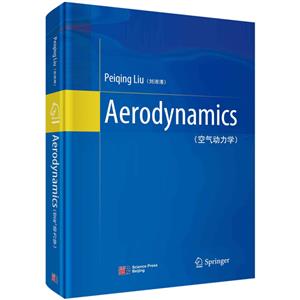-
>
宇宙、量子和人類心靈
-
>
氣候文明史
-
>
南極100天
-
>
考研數學專題練1200題
-
>
希格斯:“上帝粒子”的發明與發現
-
>
神農架疊層石:10多億年前遠古海洋微生物建造的大堡礁
-
>
聲音簡史
空氣動力學(英文版) 版權信息
- ISBN:9787030729446
- 條形碼:9787030729446 ; 978-7-03-072944-6
- 裝幀:簡裝本
- 冊數:暫無
- 重量:暫無
- 所屬分類:>
空氣動力學(英文版) 本書特色
本書是為我國航空航天工程大類專業\"空氣動力學\"課程編撰教材的英文版
空氣動力學(英文版) 內容簡介
本書是為我國航空航天工程大類專業"空氣動力學"課程編撰的教材,分空氣動力學基礎和應用空氣動力學兩大部分,重點闡述空氣動力學的基本原理與方法,以及飛行器在低速、亞聲速、跨聲速、超聲速繞流下空氣動力特性,全書共分14章。其中,空氣動力學基礎7章,包括流體運動學和動力學原理,理想流體運動微分方程組(歐拉方程組)以及旋渦運動,理想不可壓縮流體平面勢流理論和奇點疊加原理,粘性流體力學運動微分方程組(納維-斯托克斯方程組)及其特性,邊界層理論及其分離,可壓縮空氣動力學基礎;應用空氣動力學共7章,包括低速翼型繞流現象和薄翼理論,低速機翼繞流和升力線理論,翼身組合體低速繞流現象和干擾機理,亞聲速翼型和機翼繞流氣動特性,超聲速翼型和機翼繞流氣動特性,跨聲速翼型和機翼繞流氣動特性,大型飛機高升力裝置氣動特性。
空氣動力學(英文版) 目錄
Part I Fundamentals of Aerodynamics
1 Introduction 3
1.1 Aerodynamics Research Tasks 3
1.2 History of Aerodynamics 6
1.2.1 Qualitative Knowledge and Practice 6
1.2.2 Low Speed Flow Theory"10
1.2.3 High-Speed Flow Theory 26
1.3 The Leading Role of Aerodynamics in the Development of Modem Aircraft 31
1.4 Aerodynamics Research Methods and Classification 33
1.5 Dimension and Unit 37
Exercises 38
2 Basic Properties of Fluids and Hydrostatics 41
2.1 Basic Properties of Fluids 41
2.1.1 Continuum Hypothesis 41
2.1.2 Fluidity of Fluid 44
2.1.3 Compressibility and Elasticity of Fluid 46
2.1.4 Viscosity of Fluid (Momentum Transport of Fluid) 47
2.1.5 The Thermal Conductivity of the Fluid (The
Heat Transport of the Ruid) 53
2.1.6 Diffusivity of Fluid (Mass Transport of Fluid) 54
2.2 Classification of Forces Acting on a Differential Fluid Element 56
2.3 Isotropic Characteristics of Pressure at Any Point in Static Fluid 58
2.4 Euler Equilibrium Differential Equations 60
2.5 Pressure Distribution Law in Static Liquid in Gravitational Field 65
2.6 Equilibrium Law of Relative Static Liquid 71
2.7 Standard Atmosphere 72
Exercises 77
3 Foundation of Fluid Kinematics and Dynamics 85
3.1 Methods for Describing Fluid Motion 86
3.1.1 Lagrange Method (Particle Method or Particle System Method) 86
3.1.2 Euler Method (Space Point Method or Flow Field Method) 88
3.2 Basic Concepts of Flow Field 94
3.2.1 Steady and Unsteady Fields 94
3.2.2 Streamline and Path Line 95
3.2.3 One-Dimensional, Two-Dimensional and Three-Dimensional Hows 98
3.3 Motion Decomposition of a Differential Fluid Element 99
3.3.1 Basic Motion Forms of a Differential Fluid Element 99
3.3.2 Velocity Decomposition Theorem of Fluid Elements 104
3.4 Divergence and Curl of Velocity Field 106
3.4.1 Divergence of Velocity Field and Its Physical106
Significance 3.4.2 Curl and Velocity Potential Function of Velocity Field 109
3.5 Continuous Differential Equation 112
3.5.1 Continuity Differential Equation Based on Lagrange View 112
3.5.2 Continuity Differential Equation Based on Eulerss Viewpoint 113
3.6 Differential Equations of Ideal Fluid Motion (Euler Equations) 116
3.7 Bernoulli^ Equation and Its Physical Significance 120
3.7.1 Bernoulli Equation 120
3.7.2 Application of Bernoulli Equation 125
3.8 Integral Equation of Fluid Motion 133
3.8.1 Basic Concepts of Control Volume and System 133
3.8.2 Lagrangian Integral Equations 135
3.8.3 Reynolds Transport Equation 137
3.8.4 Eulerian Integral Equations 141
3.8.5 Reynolds Transport Equation of the Control Volume with Arbitrary Movement Relative to the Fixed Coordinate System 143
3.9 Vortex Motion and Its Characteristics 145
3.9.1 Vortex Motion 145
3.9.2 Vorticity, Vorticity Flux and Circulation 148
Exercises 181
4 Plane Potential Flow of Ideal Incompressible Fluid 189
4.1 Basic Equations of Plane Potential Flow of Ideal Incompressible Fluid 189
4.1.1 Basic Equations of Irrotational Motion of an Ideal Incompressible Fluid 190
4.1.2 Properties of Velocity Potential Function 192
4.1.3 Stream Functions and Their Properties 194
4.1.4 Formulation of the Mathematical Problem of Steady Plane Potential Flow of Ideal Incompressible Fluid 199
4.2 Typical Singularity Potential Flow Solutions 200
4.2.1 Uniform Flow 201
4.2.2 Point Source (Sink) 202
4.2.3 Dipole 204
4.2.4 Point Vortex 207
4.3 Singularity Superposition Solution of Flow Around Some Simple Objects 210
4.3.1 How Around a Blunt Semi-infinite Body 210
4.3.2 Flow Around Rankine Pebbles 214
4.3.3 Flow Around a Circular Cylinder Without Circulation 217
4.3.4 Flow Around a Cylinder with Circulation 222
4.4 Numerical Method for Steady Flow Around Two-Dimensional Symmetrical Objects 227
Exercises 232
5 Fundamentals of Mscous Fluid Dynamics 235
5.1 The Viscosity of Fluid and Its Influence on Flow 235
5.1.1 Viscosity of Fluid 236
5.1.2 Characteristics of Viscous Fluid Movement 236
5.2 Deformation Matrix of a Differential Fluid Element 239
5.3 Stress State of Viscous Fluid 241
5.4 Generalized Newton’s Internal Friction Theorem (Constitutive Relationship) 245
5.5 Differential Equations of Viscous Fluid MotionNavier-Stokes Equations 249
5.5.1 The Basic Differential Equations of Fluid Motion 249
5.5.2 Navier-Stokes Equations (Differential Equations of Viscous Fluid Motion) 250
5.5.3 Bernoulli Integral 252
5.6 Exact Solutions of Navier-Stokes Equations 255
5.6.1 Couette Flow (Shear Flow) 256
5.6.2 Poiseuille Flow (Pressure Gradient Flow) 257
5.6.3 Couette Flow and Poiseuille Flow Combination 259
5.6.4 Vortex Column and Its Induced Flow Field 263
5.6.5 Parallel Flow Along an Infinitely Long Slope Under Gravity 268
5.7 Basic Properties of Viscous Fluid Motion 271
5.7.1 Vorticity Transport Equation of Visco
空氣動力學(英文版) 節選
Chapter 1 Introduction This chapter mainly introduces the definition of aerodynamics, research objects and tasks, research methods and classifications, and the development history of aerodynamics, especially the leading role played in the development of modem aircraft. Learning points: (1) Definition, research object, research method, research content, and classification of aerodynamics. (2) The development history of aerodynamics and its leading role in the development of modem aircraft. 1.1 Aerodynamics Research Tasks There are five basic material forms in nature, including solid state, liquid state, gas state, plasma state, and ultra-dense state. Among them, solid corresponds to solid, liquid corresponds to liquid, and gas corresponds to gas. These three forms of matter are common and are jointly determined by the internal microstructure of matter, molecular thermal motion, and the force between molecules. The phase diagram of the object is shown in Fig. 1.1. From the perspective of macroscopic force, the force state of liquid and gas in a static state is the same (almost unable to withstand tensile and shear forces), so liquid and gas are called fluids. According to the definition, mechanics is the subject of studying the laws of equilibrium and mechanical motion of objects and their applications. Therefore, solid mechanics is the subject of studying the laws of solids in equilibrium and mechanical motion and their applications, while fluid mechanics is the subject of studying the laws of fluids in equilibrium and mechanical motion and their applications and applied disciplines. Aerodynamics is a branch of fluid mechanics. It is a discipline that studies air in equilibrium and the laws of mechanical motion and its applications. Aerodynamics is also a branch of physics, which mainly studies the laws of motion and force of air (or objects) when there is relative motion between objects and air. Traditional aerodynamics refers to the aerodynamics of aircraft, especially the aerodynamics of ordinary airplanes. Part of the force of the air on a moving aircraft is reflected in the lift (perpendicular to the flying direction of the aircraft), which acts on the aircraft; the other part is reflected in drag (opposite to the flying direction), which hinders the aircraft; and another part is caused by the resultant moment generated by the distributed pressure acting on the surface of the aircraft that controls the attitude of the aircraft. When people study aerodynamics, they often use the principle of relative flight to equate the movement of the aircraft through the air as the motion of the aircraft moving around the aircraft without moving the air. Using this principle, study the aerodynamic behavior of an aircraft when it moves in a uniform straight line at a certain speed in still air. The aerodynamic force experienced when bypassing the aircraft is equivalent, as shown in Fig. 1.2. Relative to the principle of flight, it provides convenience for the research of aerodynamics, which is the basis of aerodynamics experiments. During experimental research, people can fix the aircraft model, artificially create a straight and uniform airflow through the model, in order to observe the flow phenomenon, measure the aerodynamic force received by the model, conduct aerodynamic experimental research, and let the airflow in the wind tunnel test. Flow is easier to achieve than moving objects (as shown in Fig. 1.3). In flight mechanics, the speed relative to the aircraft is called airspeed (incoming flow speed), which is used to calculate aerodynamics; and the speed relative to the ground is called ground speed, which is used to calculate the flying distance of the aircraft. Fig. 1.1 Phase diagram of object When there is no crosswind, the airspeed and ground speed of the aircraft are equal and opposite; but when there is a crosswind, the two are different. As a classic textbook, the main content of aerodynamics foundation includes aerodynamics and dynamics foundation. In low-speed flow, incompressible ideal fluid (inviscid fluid) two-dimensional and three-dimensional potential flow, thin wing theory, lift line and surface theory, flow around swept wings, etc. Viscous fluid dynamics equations, near-wall boundary layer theory, boundary layer separation, resistance of circumfluence objects, multi-section airfoil circumfluence, etc. In the subsonic flow, the full-velocity potential function of the compressible ideal potential flow is a nonlinear elliptic partial differential equation, the theory of perturbation linearization, the Prandtl—Glauert rule, and the Carmen—Qian Xuesen formula. Fig. 1.2 Relative flight principle Fig. 1.3 Wind tunnel test In supersonic flow, small perturbation linear hyperbolic partial differential equations of compressible ideal potential flow velocity potential function, compression wave, expansion wave, shock wave, Prandtl-Meyer flow, e
- >
朝聞道
- >
伊索寓言-世界文學名著典藏-全譯本
- >
李白與唐代文化
- >
巴金-再思錄
- >
回憶愛瑪儂
- >
名家帶你讀魯迅:朝花夕拾
- >
新文學天穹兩巨星--魯迅與胡適/紅燭學術叢書(紅燭學術叢書)
- >
名家帶你讀魯迅:故事新編


















